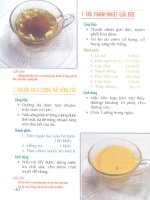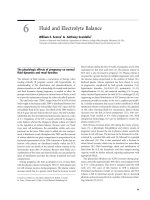Kaplan anatomy coloring book - part 9 pdf
Bạn đang xem bản rút gọn của tài liệu. Xem và tải ngay bản đầy đủ của tài liệu tại đây (512.14 KB, 21 trang )
proximal (position), 1
pseudostratified ciliated
columnar
epithelium, 23, 255
pseudounipolar neurons, 109
pterygoid plate(s), 47, 51
pubic ramus, 77
pubic symphysis, 75
pubis, 75
pudendal artery, 221
pudendal nerve, 145
pulmonary
artery, 193, 199
pulmonary
circulation, 193
pulmonary
semilunar valve,201, 203
pulmonary
trunk,
191,201,233
pulmonary
veins, 193, 199
pulp cavity, 273
pupil, 159
Purkinje fibers, 203
pyloric canal, 277
pyloric region, 277
pyloric sphincter, 277
Q
quadrants
(of
regions), 7
quadrate lobe (liver), 283
R
radial artery, 207, 213
radial nerve, 141
radial notch, 71
radial tuberosity, 71
radial veins, 223, 227
radius, 63
ramus, 45, 77
receptors, pain, 153
rectal arteries, 219, 221
rectouterine pouch, 303
rectum, 281
rectus, 161
red
blood
cells (erythrocytes), 35,195
red pulp, 241
region(s),
7,15,17
renal arteries, 217, 287, 289
renal veins, 223, 231
renal capsule, 289
renal columns, 289
renal corpuscle, 293
renal medulla, 289
renal pelvis, 289
renal pyramids, 289
reproductive system, 13,295-300,
297,301-310
respiratory system,
11,249-266
reticular connective tissue, 31
reticular fibers, 29, 31
reticular layer, 39
retina, 163, 165
return
drainage, 237
rhombencephalon,
III
ribosomes, 21
ribs, 61
rods, 165
root
canal, 273
rootlets, 135
rotation (joint), 91,101
round
ligaments, 301, 303
round
window, 169
rugae, 277, 307
s
saccule, 169
sacral crest, 59
sacral foramina, 59
sacral nerves, 137
sacral plexus, 137, 145
sacral
promontory,
59
sacral vertebrae, 53
I
KAPLAN".
Index medical
sacroiliac joint, 75
sacrum, 53, 59
saddle joints, 91
sagittal section, 3
sagittal sinus, 225
sagittal suture, 47
salivary glands, 267, 271
saphenous vein, 223, 229
scala media, 173
scala tympani, 173
scala vestibuli, 173
scaphoid, 73
scapula, 65
scapulae, 63
scapular region, 17
scapular spine, 65
Schwarm cell, 107
sciatic nerve, 145
sciatic notch, 77
sclera, 159, 163
scleral venous sinus, 163
scrotal sac, 297, 299
sebaceous gland, 41
sections, body, 3
segmental arteries, 289
sella turcica, 49, 51
semicircular canal, 171
semicircular ducts, 169, 171
seminal vesicles, 295, 297, 299
seminiferous tubules, 189,299
sense organs, 153-174
sensory nerve fibers, 155
septal cartilage, 253, 257
serosa, 277
serous layer, 201
sertoli cells, 299
shaft, hair, 41
sigmoid artery, 219
sigmoid colon, 281
327
328
meclical
I Index
sinoatrial node, 203
sinus(es)
cavity, 49
coronary, 199,201
frontal, 49
lactiferous, 309
sagittal, 225
scleral venous, 163
sphenoid, 49
sinusoids,283
skeletal muscle, 37
skeletal system, 9,
43-84
skeleton, appendicular, 63
skin, 11
skin receptors, 153
skull, 43, 45,
47,49
small intestine, 245, 267, 279
smooth
muscle, 37, 205, 291
soft palate, 253, 255, 269
soma, 105
somatic nervous system, 103
somatosensory cortex,
lIS,
125
speech area, motor, 125
spermatic cord, 297
spermatids,299
spermatocytes,299
spermatogonia, 299
spermatozoa (sperm cells), 299
sphenoid bone, 43, 45, 47, 51, 177
sphenoid sinus, 49
sphincter, pyloric, 277
spinal canal, 19
spinal cord, 9, 103, 131, 135
spinal nerve(s), 103, 135
spine, 65, 75, 77
spinous process, 55, 57
spiral organ (organ
of
Corti), 173
spleen, 9, 235, 241
splenic artery, 219, 241
splenic cords, 241
splenic flexure, 281
splenic vein, 231, 241
spongy urethra, 299
squamous
epithelium, 23, 25
squamous
portion,
51
squamous
suture, 45
stapes, 169
sternal region, 15
sternal-rib
junction,
87
sternum,
61
stomach, 11,267,277
stratified epithelia, 25
stratified
squamous
epithelium, 25
stratum
basale, 39
stratum
corneum,
39
stratum
granulosum,
39
stratum
lucidum, 39
stratum
spinosum, 39
striations, 37
styloid process, 45, 47, 51, 71
subclavian artery, 207, 209, 213
subclavian vein, 223, 227, 237
sublingual glands, 271
submandibular
glands, 271
submucosa, 277, 279
subpubic
angle, 77
subscapular artery, 213
subscapular fossa, 65
sulcus(i),
113,115,121,135
superior (position), 1
superior border, 65
superior oblique, 161
supporting
cells, 157
supracondylar ridges, 69
supraspinous fossa, 65
suprasternal notch, 61
sural region, 17
surfactant, 265
surgical neck, 69
suspensory ligaments, 163,303,307
suturets), 45, 47,85
sweat glands, 39
sympathetic chain ganglia, 149
sympathetic division, 149
symphysis, 87
symphysis pubis, 299
synapses, 105, 109
synaptic
neuron,
109
synaptic vesicles, 109
synarthroses, 85
synchondrosis, 87
syndesmosis, 85
synovial cavity, 89
synovial fluid, 89
synovial joints, 85, 89, 91,93
synovial membranes, 89
system(s)
autonomic
nervous, 103, 149, 151
cardiovascular, 13, 191-234
central nervous, 103
digestive, 11, 219, 267
endocrine, 11, 175
female reproductive, 301-310
hepatic portal, 231
integumentary, 11, 39
limbic, 123
lymphatic, 9, 235
male reproductive, 295-300, 297
muscular, 9
organ,
5,9-13
peripheral nervous, 103
portal,231
respiratory, 11,249-266
skeletal, 9,
43-84
somatic nervous, 103
urinary, 13,287
systemic circulation, 193
T
T cells,
195,247
talus, 83
tarsal
bones,
83
tarsals, 79
taste
buds,
155
taste
pore,
155
teeth,273
temporal
vein, 225
temporomandibular
joint, 95
tendon
sheath,
89
tendon,
patellar, 99
teniae coli, 281
terminal
nerves, 137
testes, 13, 175,
189,295,297
testicular artery, 297
thalamus,
119, 121
third
ventricle, 121, 127
thoracic
aorta,
207,217
thoracic nerves, 137
thoracolumbar
division, 149
thrombocytes
(platelets), 195
thymus,
237
thyroid cartilage, 251, 257, 259
thyroid
gland, 11, 175, 181
thyroid
stimulating
hormone,
179
tibia, 79, 81
tibial artery,
207,215
tibial condyle, 81
tibial crest, 81
tibial tuberosity, 81
tibial veins, 229
tibofemoral
joint, 99
tissue(s), 5,
21-42
tongue,
155,239,269
tonsillar (Waldeyer's) ring, 239
tonsils, 155,239
trabeculae carneae, 201
trachea,
11,249,251,257,259,261
tracheal
rings, 261
trachealis muscle, 261
transitional
epithelium,
25
transverse processes, 57
trapezium,
73
trapezoid,73
tricuspid
valve,
201,203
trigeminal
nerve, 133
trigone, 291
trilaminar
germ
disk, 313
triquetrum,
73
trochanter,
79
trochlea, 69
trochlear
nerve, 133
trochlear
notch,
71
trophoblast,311
true
pelvis, 75
trunk
veins, 231
tuberosity, 71, 77
tubule(s),
189,293,299
tunica
externa
(tunica
adventitia),
205
tunica
intima
(tunica
interna),
205
tunica
media, 205
two-celled stage, 311
tympanic
cavity, 169
tympanic
membrane
(ear
drum),
167
type
11
alveolar cells, 265
u
ulna, 63
ulnar
artery, 207, 213
ulnar
nerve, 141
ulnar
notch,
71
ulnar
veins, 223, 227
umbilical arteries, 233
umbilical region, 7
umbilical vein, 233
upper
dermis,
153
d
I
KAPLAff.
In ex medical
upper
extremity, 63
upper
limb
arteries, 213
upper
limb
veins, 227
ureteral orifices, 291
ureters, 287, 289,
291,297
urethral
orifice, 309
urethra,
13,287,291
urinary
bladder, 287, 291, 297
urinary
system,
13,287
urogenital triangle, 309
uterine
arteries, 221
uterine
tubes,
301,303,307
uterosacral ligament, 307
uterus,
301, 303, 307
utricle, 169
uvula, 269
v
vagina,
301,303,307
vaginal arteries, 221
vaginal orifice, 309
vagus nerve, 133
vallate papillae, 155
valve(s),
201,203
vasopressin, 179
vein(s)
antebrachial,227
axillary, 223, 227
azygos, 231
basilic, 223, 227
brachiocephalic, 223, 225
cardiac, 197, 199
central,283
cephalic, 223, 227
colic, 231
cubital,227
digital, 227, 229
dorsal,299
329
330
",~&ical
I Index
facial, 225
femoral, 191,223,229
gastric, 231
gastroepiploic, 231
gonadal, 223, 231
head, 225
hemiazygos, 231
hepatic portal, 231,283
iliac, 223, 229
intercostal, 231
jugular,
191,223,225,237
lower limb, 229
maxillary, 225
mesenteric, 231
metatarsal, 229
neck, 225
palmar
arch, 227
plantar, 229
popliteal, 229
pulmonary, 193, 199
radial, 223, 227
renal, 223, 231
saphenous, 223, 229
splenic, 231, 241
subclavian, 223, 227, 237
temporal, 225
tibial, 229
ulnar, 223, 227
umbilical, 233
upper
limb, 227
vena cava, 191,
193,201,223,225,
231,233
vertebral, 223, 225
vena cava veins, 191, 193,201,223,
225,231,233
ventral cavity, 19
ventral root, 135
ventricle(s), 119,121, 127, 193,201
venules, 193, 235
vermiform appendix, 281
vertebrae, 53, 57
vertebral arch, 57
vertebral arteries, 211
vertebral column, 53
vertebral foramen, 55, 57
vertebral region, 17
vertebral vein, 223, 225
vesical arteries, 221
vesicles, 21,
27,109,295,297,299
vessels, 205, 245, 309
vestibular fold, 259
vestibular
membrane,
173
vestibule, 169
vestibulocochlear nerve, 133
vetebral foramen, 55
villi, 245, 279
visceral pericardium, 201
visceral pleura, 263
visual association area, 125
vitreous
humor,
163
vocal cord, 259
vocal fold, 257
vomer, 47, 49, 253
w
Waldeyer's (tonsillar) ring, 239
Wernicke's area, 125
white
blood
cells, 35, 195
white matter, 121
white pulp, 241
wings, 47, 51
x
xiphoid process, 61
y
yolk sac, 313
z
zona fasciculata, 187
zona glomerulosa, 187
zona reticularis, 187
zygomatic bones, 43
zygomatic process, 45, 51
zygote, 311
Special
Flashcard
Section: Muscles of the Human
Body
331
INTRODUCTION
Muscles can be
grouped
into anatomical regions such as muscles
of
the head,
arm
or torso.
Muscles can also be functionally related, for example, muscles
that
act on the thigh or
muscles that flex the hand.
Origin, Insertion, Action
The
origin
of
the muscle is the stable
part
of
the muscle. The majority
of
muscles have
origins that are superior, proximal, or medial to the insertion. There are only a few
exceptions to this rule. The
insertion
of
the muscle is the
part
of
the muscle
that
has the
greatest
motion
when the muscle contracts. In some cases a muscle can move either
the
origin or the insertion
and
you
should
learn the origins
and
insertions as presented. The
action
of a muscle is what
the
muscle does. Some muscles are flexors
and
decrease joint
angles. Some are extensors, adductors, abductors, rotators, etc. The action
of
the muscle is
every movement the muscle does.
When you study muscles, it helps to take two or three at a time
and
learn just the origins
of
the muscles.
When
you know those,
then
study the insertions,
and
finally, the actions. After
you know the muscles well,
then
take
another
group
of
muscles
and
add
them
to the list. If
you
try
to learn twenty muscles at a time, the task will be frustrating, so it is best to take
them
in small groups.
Muscle Names
The muscles are
named
by different criteria
and
understanding
how they are
named
can help
you to remember the muscle. Muscles can be
named
for their shape. The trapezius is a
trapezoid-like muscle. The
rhomboideus muscles are shaped like a rhombus. Muscles can be
named
by the
number
of
heads they have. The triceps brachii has three heads. Muscles can be
named
by location.The rectus abdominis literally means
"the
straight muscle
of
the
abdomen." The
tibialis anterior is the front muscle on the tibia. Muscles can be
named
according to size. The teres
major
is the large muscle
and
the
teres
minor
is the small muscle.
Teres means "round." Some muscles are superficial while others are deep. The flexor
digitorum
superficialis is superficial to the flexor digitorum profundus. Muscles can also be
named
for their action. There are
the
adductors,
the
flexors
and
extensor muscles, etc.
Muscles
that
cross joints
of
the
body
move those joints. The
main
muscle
that
causes the
joint to move is called the
prime
mover
or agonist. A muscle
that
helps the
prime
mover is
called a synergist. A muscle
that
opposes the
prime
mover is called an
antagonist.
If
both
the
prime mover
and
the antagonist contract,
then
the
joint
is fixed,
Muscle Groups
There are groups
of
muscles
that
act together. The
rotator
cuff
(musculotendinous
cuff)
muscles stabilize the shoulder joint. These are the supraspinatus, the infraspinatus the teres
minor
and
the subscapularis. The
abdominal
muscles
are the rectus abdominis, the external
oblique, the internal oblique,
and
the transversus abdominis. The
quadriceps
femoris
group
are the muscles
of
the anterior thigh. These are the rectus femoris, the vastus lateralis, the
vastus medialis,
and
the vastus intermedius. The
hamstrings
are muscles on the posterior
thigh
and
they consist
of
the biceps femoris, the semitendinosus,
and
the semimembranosus.
There are many more functional groups
of
muscles
but
these are a few
of
the major ones.
The muscles
of
the body are
numerous
and
flash cards are a great tool to learn muscles.
Cut
out
the
cards along the lines. As we said before, it is best to take a few cards at a time
and
learn
them
well. Youshould color each muscle on the front side
of
the card
and
put
a small
'0'
where the origin
of
the muscle is
and
a small 'I" where
the
insertion
of
the muscle is. Each
muscle is illustrated isolated from
other
muscles so
that
the
origin
and
the insertion are
plainly visible. The
name
of
the muscle is on the back
of
the illustration. The origin
(0),
insertion (I),
and
action (A) are listed for each muscle on the back
of
the
card.
Special Muscle Flashcard Section I
KAPLAlf
d
- I
333
Muscles of the Human Body me lea
MUSCLES,
ANTERIOR
VIEW
Answer
Key:
a. Sternocleidomastoid, b.
Pectoralis
major,c. Deltoid, d. Bicepsbrachii,e.
Rectus
abdominis, f.
External
oblique, g.
Sartorius,
h. Quadriceps femoris, i.Tibialisanterior
Special
Muscle
Flashcard
Section
I
KAPLA~.
I
335
Muscles
of the Human
Body
meulCa
MUSCLES,
POSTERIOR
VIEW
b. _
J
Answer
Key:
a.
Trapezius,
b. Deltoid,
c.Triceps
brachii,d.
Latissimus
dorsi,e.
Extensor
digitorum, f. Gluteus maximus,g. Adductor
magnus,
h. Iliotibialtract,i. Bicepsfemoris, j. Gastrocnemius
0:
Occipital
bone
and
temporal
bone
I: Galea
aponeurotica
A: Pulls scalp posteriorly
MASSETER
0:
Zygomatic arch
I: Ramus
of
mandible
A: Closes
mandible
ORBICULARIS
OCULI
0:
Frontal
bone
and
maxilla on
medial
orbit
I: Eyelid
A: Closes eye
FRONTALIS
0:
Galea
aponeurotica
I: Skin
near
eyebrows
A: Raises eyebrows, pulls scalp
anteriorly
TEMPORALIS
0:
Temporal fossa
I:
Coronoid
process
and
ramus
of
the
mandible
A: Closes
mandible
MEDIAL AND
LATERAL
PTERYGOIDS
0:
Pterygoid processes
of
sphenoid
bone
I:
Ramus
and
condylar
process
of
mandible
on
medial side
A: Lateral
movement
of
mandible
0:
Anterior, medial mandible
I: Skin
of
chin
A: Elevates lower lip
ZYGOMATICUS
0:
Zygomatic
bone
I: Angle
of
mouth
A: Elevates corners
of
mouth
(in a smile or laugh)
DEPRESSOR
LABII
INFERIORIS
0:
Inferior
border
of
mandible
I: Skin
of
inferior lip,
and
orbicularis oris muscle
A: Depresses lower lip
ORBICULARIS
ORIS
0:
Muscles encircling
mouth
I: Skin of lips
A: Closes
mouth
BUCCII\JATOR
0:
Mandible
and
maxilla
I: Orbicularis oris
A: Tightens cheek
SCALENUS
0:
Transverse process
of
C
2-6
I:
Ribs]
and
2
A: Flexes
and
rotates neck, elevates first
and
second ribs
,
I
i
,
I~
j/
I
I
LEVATOR
SCAPULAE
0:
Transverse processes
of
Cl-4
I: Superior angle of scapula
A: Elevates scapula, rotates
and
abducts neck
STERNOHYOID
0:
Manubrium
of
sternum
I: Hyoid
bone
A: Depresses hyoid
bone
OMOHYOID
0:
Superior
border
of
scapula
I: Hyoid
bone
A: Depresses hyoid
STERNOCLEIDOMASTOID
0:
Sternum
and
clavicle
I: Mastoid process
A: One: rotates
and
extends head, both: flexes neck
STERNOTHYROI
D
0:
Manubrium
of
sternum
I: Thyroid cartilage
of
larynx
A: Depresses thyroid cartilage
PLATYSMA
0:
Fascia over pectoralis
major
and
deltoid muscles
I: Mandible
and
skin inferior to lower lip
A: Depresses lower lip
\
\l~!I'I/4)
Iii
I
DIGASTRIC
0:
Anterior, inferior mandible, mastoid
notch
of
temporal
bone
I: Hyoid
bone
A: Protracts, retracts,
and
elevates hyoid,
opens
mandible
TRAPEZIUS
0:
Occipital
protuberance,
ligamentum
nuchae,
C7-Tl2
I: Clavicle, acromion,
and
spine
of
scapula
A: Abducts
and
extends head, rotates
and
adducts
scapula
LATISSIMUS
DORSI
0:
T7-TI2,
Ll-LS,
sacrum, iliac crest, ribs 10-12
I: Intertubercular groove
of
humerus
A: Adducts, extends,
and
medially rotates
arm,
pulls
shoulder
inferiorly
MYLOHYOID
0:
Inner
margin
of
mandible
I: Hyoid
bone
A: Elevates floor
of
oral cavity
SPLENIUS
0:
Ligamentum
nuchae,
C7-T6
I:
C2-4,
occipital bone,
temporal
bone
A: Extends
and
rotates head
SEMISPINALIS
0:
C4-T12
I: Occipital bone,
TI-4
A: Extends head, rotates vertebral
column
j
j
j
j
j
j
j
j
j
j
j
j
j
j
j
j
j
j
j
j
j
j
j
j
j
j
j
j
j
j
j
j
j
j
j
j
j
j
j
j
j
j
j
j
j
j
j
j
j
j
j
j
j
j
j
j
j
j
j
j
j
j
j
j
j
j
j
j
/
!
DELTOID
0:
Clavicle, acromion,
and
spine
of
scapula
I: Deltoid tuberosity
A: Abducts, flexes, extends medially,
and
laterally rotates
arm
INFRASPINATUS
0:
Infraspinous fossa
I: Greater tubercle
of
humerus
A: Extends, laterally rotates
arm,
stabilizes
shoulder
SU
BSCAPU
LARIS
0:
Subscapular fossa
I: Lesser tubercle
of
humerus
A: Extends, medially rotates
arm,
stabilizes
shoulder
SU
PRASPI
NATUS
0:
Supraspinous fossa
I: Greater tubercle
of
humerus
A: Abducts
arm,
stabilizes
shoulder
TERES
MINOR
0:
Axillary
border
of
scapula
I: Greater tubercle
of
humerus
A: Extends, laterally rotates, adducts arm, stabilizes
shoulder
RHOMBOIDEUS
MAJOR
0:
Tl-T4
I: Inferior, medial
border
of
scapula
A: Adducts scapula
!
))
/
/
TERES
MAJOR
0:
Axillary
border
of
scapula
I: Crest of lesser tubercle
of
humerus
A: Extends, adducts, medially rotates
arm
ERECTOR
SPINAE:
(SPINALIS,
LONGISSIMUS,
ILIOCOSTALIS)
AND MULTIFIDUS
0:
Vertebral column, ilium, sacrum, ribs
I: Ribs, vertebral column, occipital bone,
temporal
bone
A: Rotates
and
extends vertebral
column
and
head
QUADRATUS
LUMBORUM
0:
Iliac crest, lower
lumbar
vertebrae
I:
T12,Ll-L4,rib
12
A: Abducts vertebral column, depresses rib 12
RHOMBOIDEUS MINOR
0:
Ligamentum nuchae,
C6-C7
I: Superior, medial
border
of
scapula
A: Adducts scapula
PECTORALIS
MAJOR
0:
Clavicle,
sternum,
and ribs
1-7
I: Crest
of
greater tubercle of
humerus
A: Adducts, flexes,
and
rotates
arm
medially
SERRATUS
ANTERIOR
0:
Ribs
1-8
or 9
I: Vertebral
border
of
scapula
A: Abducts scapula
MINOR
0:
Ribs
3-5
I:
Coracoid process of scapula
A: Depresses scapula, elevates ribs
3-5
EXTERNAL
INTERCOSTALIS
0:
Inferior
margin
of ribs
1-11
I: Superior margin
of
ribs
2-12
A: Elevates ribs (increases thoracic volume)
DIAPHRAGM
0:
Xiphoid process, ribs
10-12,
lumbar
vertebrae
I: Central
tendon
A: Inspiration
INTERNAL
INTERCOSTALIS
0:
Inferior margin
of
ribs
I-II
I: Superior margin
of
ribs
2-12
A: Depresses ribs (decreases thoracic volume)
RECTUS
ABDOMINIS
0:
Symphysis pubis
and
pubic
crest
1:
Cartilages
of
ribs
5-7
and
xiphoid process
A:
flexes
lumbar
vertebrae, compresses
abdomen
INTERNAL
OBLIQUE
0:
Inguinal ligament, iliac crest
I: Linea alba, inferior 4 ribs
A: Compresses
abdomen,
laterally rotates
trunk









